#the Andes plane crash
Text
Okay…
I get it if you’re a fan and “Alive” is nostalgic for me, I won’t lie but …
Saying that it’s the better version and that “La Sociedad de la Nieve” is a copy/paste of it is just not true. Stop deluding yourself.
Alive was written very soon after the rescue and did exactly what the survivors did not want. It dramatized their story. Hollywood took it further. Sure, some survivors got involved in that movie behind the scenes but that was so they could try and make sure Hollywood didn’t take it completely off the rails. It doesn’t even have the real names of most of the passengers and crew.
Also, Piers Paul Read is an American journalist while Pablo Vierci personally knows and has worked very closely with the survivors to tell the story the way it happened.
I think that should also say a lot.
#la sociedad de la nieve#alive#the Andes plane crash#piers paul reads book was very judgey I also found#I noticed that right away#he also greatly mis-characterized some of the boys#I was actually appalled when I read that#society of the snow#my rants#I got really fed up with this ‘debate’#ugh 🙄🙄🙄#my opinion
34 notes
·
View notes
Text
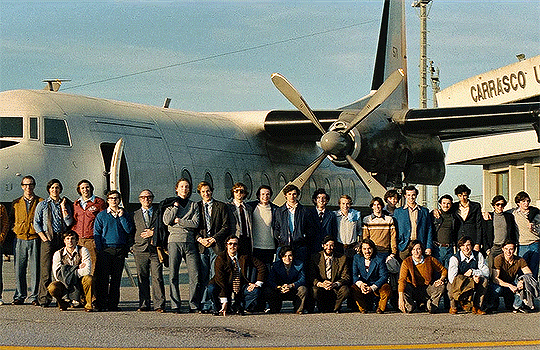
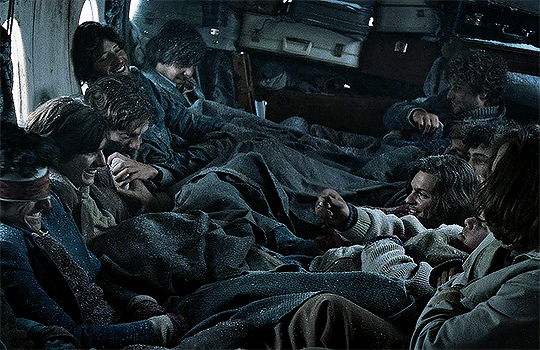
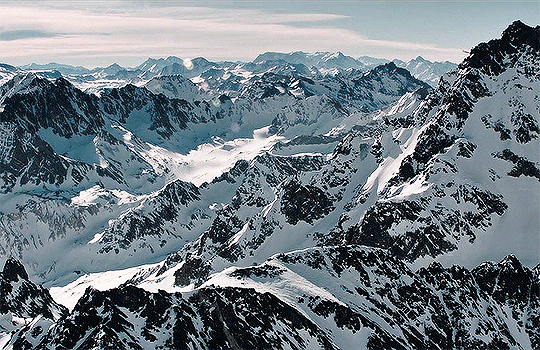



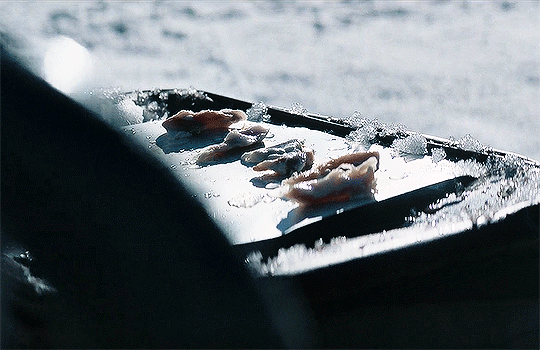
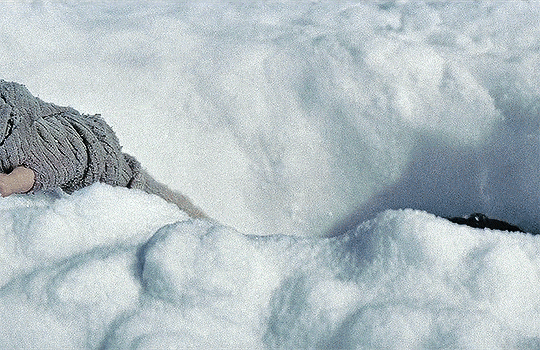
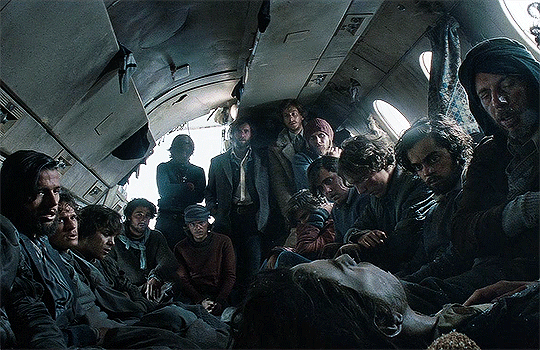
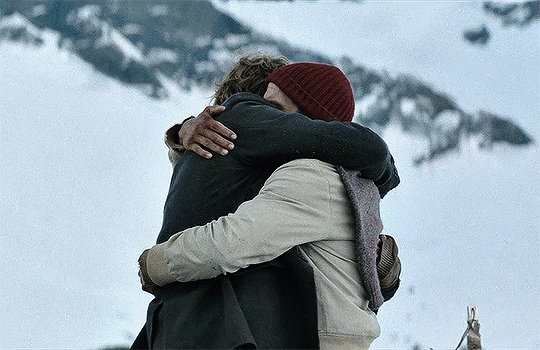
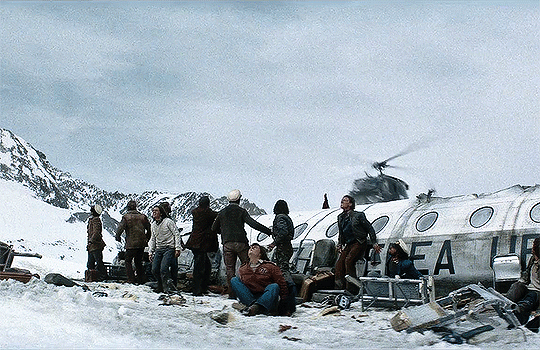

“𝑻𝒉𝒆𝒓𝒆 𝒊𝒔 𝒏𝒐 𝒈𝒓𝒆𝒂𝒕𝒆𝒓 𝒍𝒐𝒗𝒆 𝒕𝒉𝒂𝒏 𝒕𝒐 𝒈𝒊𝒗𝒆 𝒐𝒏𝒆'𝒔 𝒍𝒊𝒇𝒆 𝒇𝒐𝒓 𝒇𝒓𝒊𝒆𝒏𝒅𝒔.”
Society of the snow (2023)
#society of the snow#la sociedad de la nieve#netflix#numa turcatti#andes#andes mountains#my edit#mine#film edit#movie edit#miracle in the andes#los andes#andes plane crash#history#roberto canessa#nando parrado#enzo vogrincic
768 notes
·
View notes
Text
why I'm happysad that they let Numa be the narrator in Society of the Snow.
So if you, like me, have been more than a little obsessed with the story of Uruguayan Air Force Flight 571 for a very, very long time, your stomach probably dropped like mine did when the narrator introduced himself as Numa Turcatti. (My immediate thought was, "why would you do this to us?!") If you went in blind, I feel for you!
But while the film gave us a version of Numa, since it's from his perspective what it doesn't really give us is the group's perspective on him. He comes across a bit like an outsider, and although, yes, his only surviving friend was Pancho Delgado, he wasn’t an outsider for long at all. On the contrary. So, here are a few excerpts from the books that tell you more about what he was like and how much they all loved him, because I feel like that’s important.
From Alive, Piers Paul Read:
Next to Parrado, Numa Turcatti was the most generally beloved of the boys. [...] Since he had known few of the boys before leaving Montevideo, it was proof of his strength, simplicity and complete lack of malice that he became so loved and respected by them.
On celebrating Numa's birthday while trapped under the avalanche:
The boys gave him an extra cigarette and made a birthday cake out of snow. [...] Many would have liked to give him a better time on his birthday, but instead it was he who improved their spirits. "We have survived the worst," he said. "From now on, things can only get better."
From Society of the Snow, Pablo Vierci:
‘When I talk about Numa, I can’t help but cry,’ says Coche Inciarte. ‘He’s the best person I’ve ever met in my life. However tenderly I cared for those who were losing heart, Numa did it much better because he never got tired. He was constantly aware of everyone else’s distress. He radiated peace, he never gave up, and when he came near me, I felt like Jesus Christ himself was among us, with such mercy and compassion in his eyes. I don’t know where he got his strength.’
‘I could never imagine him living in everyday life, because I met him and I loved him in that torment of the Andes,’ says Coche. ‘He had a hard time eating, like I did. We ate the bare minimum in order to survive. I lost one hundred pounds, he lost more. And just like me, his leg became infected after the avalanche. We operated on our legs together with a razor blade. But he deteriorated more quickly than I did, because he had given so much more; he had been too generous.’
Moncho Sabella:
Numa taught us about the anonymous heroism of giving more of himself to others than he reserved for himself. In that balance between solidarity and selfishness, which decided whether you lived or died, he tilted the balance in favour of the others to the detriment of himself. [...] And when the avalanche came and covered the plane, the one who worked the hardest, the one who removed the most snow so that we could come back to life, was Numa. Again, he was exceeding his own limits. [...] In the end, his immune system was so devastated that he got one infection after another. We gave him antibiotics and the doctors on the mountain attended to him every day, but finally he left us. And with him, we all died a little more.
Gustavo Zerbino:
I always remember Numa up there, full of despair, when he told us that he would rather die watching the sky, walking, instead of ending life immobilised in a cave of broken metal. For that reason, after the avalanche, he kept digging and removing snow without rest until he burned himself out with exhaustion. He always thought that his time had come but he wanted to work until the final moment, doing whatever he could to help. I cared for him all those days; I saw how he was hurried to the brink of death, with no defences, getting one infection after another. I went up to him and first I gave him a kiss on the cheek to greet him and asked him how he was doing. He just stared at me with a kind of infinite peace. He never complained. But Numa was quickly deteriorating: from that physical strength and vigour he had had at the beginning, he finished as a skeletal dying boy. He held on to his characteristic qualities until the end though. He was that same stoic guy when he was strong and when he was wasting away.
‘Gustavo Zerbino didn’t tell us the whole truth [about the expedition] because he didn’t want us to be discouraged. When I asked Numa about it, he couldn’t lie and he told me: “As far as we went, all you could see were more mountains.” But even so, he always wanted to be an expeditionary. “I want to go,” he told me, even though I knew at once he could never go, he was too exhausted and too hurt.’ So Numa approached Daniel Fernández, knowing that he had influence over the others, and he tried to convince him: ‘I can do it, Daniel, please believe me. I can do it.’ Daniel recalls, ‘When I told him that his injury made it impossible, he started working even harder than ever, like a bull, shovelling snow to unbury the plane after the avalanche to show that yes, he could do it.’
Finally, from Alive, after Numa died:
On this particular afternoon, Javier Methol lay at the back of the plane. "Be careful," he said to Coche as he rose and stepped over Numa's body. "Be careful not to step on Numa."
"But Numa's dead," said Parrado.
Javier had not realised what had happened, and now that he understood his spirits dropped completely. He wept as he had wept at the death of Liliana, for he had grown to love the shy and simple Numa Turcatti as though he were his brother or son.
I'm not sure the Numa we see in the film is quite the same person that he actually was on that mountain, but I'm so, so glad that he got a voice. He fought so hard for them all.
So, yeah. In the immortal words of Jake Peralta,

212 notes
·
View notes
Text
Agustin Pardella as Nando Parrado
Second portrait of the cast!
Os quiero

#la sociedad de la nieve#society of the snow#lsdln#ja bayona#nando parrado#miracle in the andes#andes plane crash#agustin pardella
153 notes
·
View notes
Text
On this day in 1972, two helicopters arrived in the Valley of Tears, where the severed fuselage and 14 survivors waited for rescue
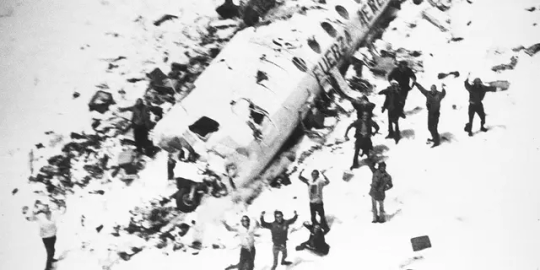
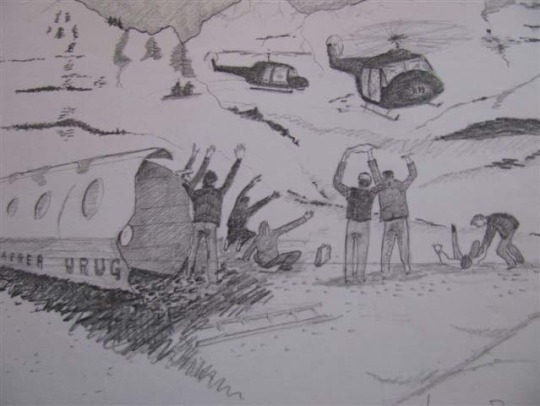
Drawing by survivor Coche Inciarte
Nando and Roberto were shown maps and asked to point out where the rest of the survivors were. When they did, the rescuers said "That can't be it! That's all the way in Argentina! You couldn't have crossed the Andes on foot!".
But Nando and Roberto insisted they knew what they were talking about.
Nando was in one of the helicopters, otherwise the rescue team would not have been able to locate the wreckage (the white plane could not be seen from above in the snowy scenery). That took amazing bravery, given what he had just gone through. Weather conditions weren't the best, so the helicopters shook and swayed.
Not all 14 could fit in both helicopters, so Pancho Delgado, Antonio Vinzintín, Moncho Sabella, Bobby François, Gustavo Zerbino, Fito Strauch, Roy Harley and Javier Methol stayed behind with three mountaineers and a nurse. Due to the weather, they were only rescued on the 23d.


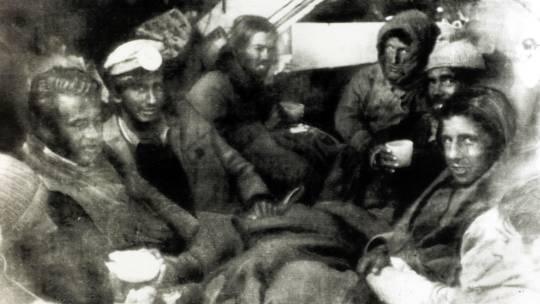
from left to right: Fito, Gustavo, Bobby, Roy, Pancho and Moncho
Actual footage of the first group being taken care of in Los Maitenes:
youtube
Footage of the first arrivals in Los Maitenes (pay attention to the survivors hugging, specially Nando and Carlitos tumbling to the ground <3):
Footage of the second group arriving at the hospital:
147 notes
·
View notes
Text
I’m reading Roberto Canessa’s book and I’m at chapter 7 where he mentions wearing the sweater his girlfriend gave him while stuck in the Andes and that he still has it to this day 😭❤️
#roberto canessa#book#I had to survive#how a plane crash in the Andes inspired my calling to save lives#la sociedad de la nieve#society of the snow
52 notes
·
View notes
Text



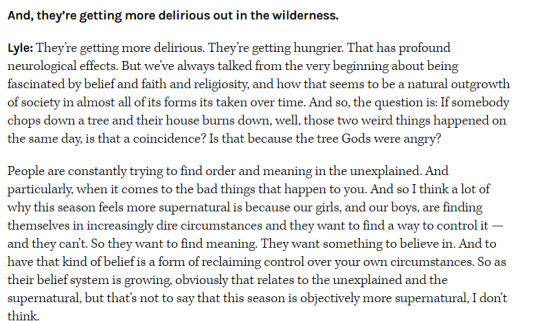
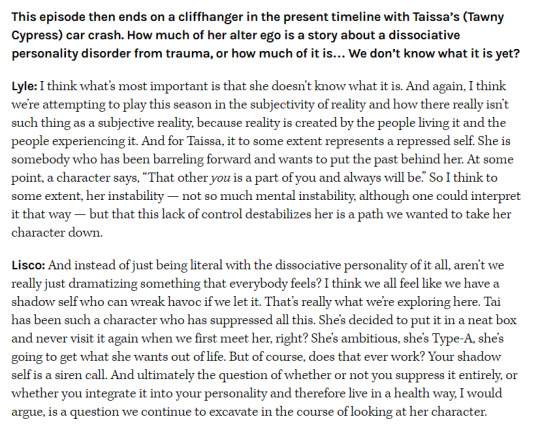
THR Yellowjackets interview
#yellowjackets#i agree that it's not so transgressive!!!#i went on an andes plane crash reading kick shortly before s2 started airing and firmly came down on 'who among us would not'#i really liked this interview bc i think it nailed 'problematic' as a nonsense word#without ever directly even bothering to address those people#just: we're not particularly concerned about likability and it's bc we can do our fucking jobs
175 notes
·
View notes
Text
I stayed up until 4am to finish the book about the Andes plane crash (Alive by PP Read) and as someone who absolutely adores Lord of the Flies this was fascinating. They create such interesting rituals and group dynamics, I have so many thoughts. They were so lucky that their leaders turned out to be different people than the physically fittest boys! I think this is one of the key elements of the consistently calm environment they made for themselves: They allowed the expeditionaries luxuries like the best sleeping spots and unlimited meat (and it’s described that some of the chosen take advantage of that), but the decision is actually made by the ones who stay behind in the wreck. Also their lack of rule enforcement for hygiene shocked me more than anything else. That brings me to the elephant in the room: the way of viewing the cannibalism as communion… the ritualisation of it was actually an attempt at rationalisation, to enable them to distance themselves from it. and then in the aftermath the pastor was trying hard to say no actually that’s not communion but also you’re not sinners for doing it and going “you are neither saints nor sinners” damn that hit
23 notes
·
View notes
Text
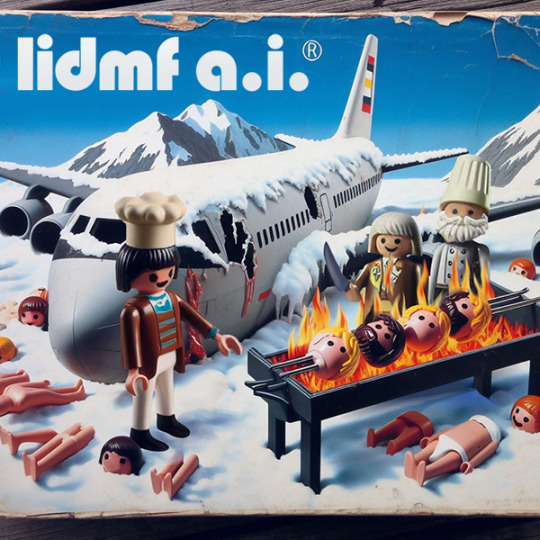
LIDMF AI + PHOTOSHOP
"The Meat Society"
#andes#risas#lol#humor#jajaja#xd#funny#funny pics#lolz#horror#terror#miracle in the andes#andes mountains#los andes#andes plane crash#argentinien#travel#la sociedad de la nieve#society of the snow#colombia#airplane#plane#aircraft#aeroplane#aviation#fighter jet#plane crash#cannibalposting#bones and all#no id
17 notes
·
View notes
Text
I just watched Society of the Snow (La sociedad de la nieve).
It’s a film about the 1972 Andes plane crash and the survivors.
Brutal, harrowing stuff.
#dougie rambles#personal stuff#films#cinema#society of the snow#la sociedad de la nieve#uruguay#Chile#andes#plane crash#1972#Andes plane crash
15 notes
·
View notes
Text
yesterday i watched society of the snow (la sociedad de la nieve para los panas) and i think i should read the survivors' books. i've heard "viven" it's very well written, for the kind of experience that was
#for those who don't know it's the story about the rugbiers whose plane crashed and#they spent more than two months trapped in los andes#ela.txt
8 notes
·
View notes
Text
the andes plane crash is a great topic for my father and i to talk about because he gets to enjoy the rugby and i get to enjoy the cannibalism
9 notes
·
View notes
Video
youtube
yeah watching Yellowjackets now and it is this, just with American girls from the 90s which means of course it all ends in murder and occultism.
12 notes
·
View notes
Text

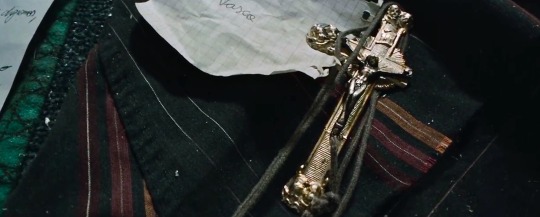
In a special place in my home I keep only memories, keepsakes from the cordillera: photos of many of those who died, objects from the plane, things I collected from everyone who died and who we did not expect to stay alive. So I save them in this altar, which is my most sacred and beloved piece of furniture. I carried back a lot of objects in a bag, but there were some things that we didn’t know which dead boy they belonged to, nor did any survivor recognise it as his own. [...] I have dozens of things from ’72.
But the thing I value most, because I feel that it symbolises everything we lived through, is a silver cross that is missing its left arm. It is a cross that somebody had hanging over his heart, although I found it lying in the snow. It is about 4cm long, and the whole arm that’s left measures less than 2cm. It suffered some sort of violent impact in the centre – whoever had it received a severe blow to the middle of his chest. But what moves me most about it is that despite being dented, despite the fact that it’s missing an arm, with the metal all jagged and torn, all the same it keeps being, unmistakably, a cross. That was what happened to us. We were dented and bruised, beaten down and terribly abused, but we kept on being whole men.
#today in details i'm so glad they included in this movie#that cross means so much to him#society of the snow#gustavo zerbino#uruguayan flight 571#andes plane crash#pablo vierci
106 notes
·
View notes
Text
Matías Recalt as Roberto Canessa
I'm still alive. Just forgot that i had an account here lol
I loved this movie and i'm so grateful to have a great director as Bayona here in Spain.
Cried for 30 mins too.

#la sociedad de la nieve#society of the snow#2023 movies#matias recalt#roberto canessa#miracle in the andes#andes plane crash#andes mountains#netflix movie#ja bayona#j.a. bayona
160 notes
·
View notes
Text
The Survivors (Part 1)
In alphabetical order.
The photos and some of the information are from Sociedad de la Nieve
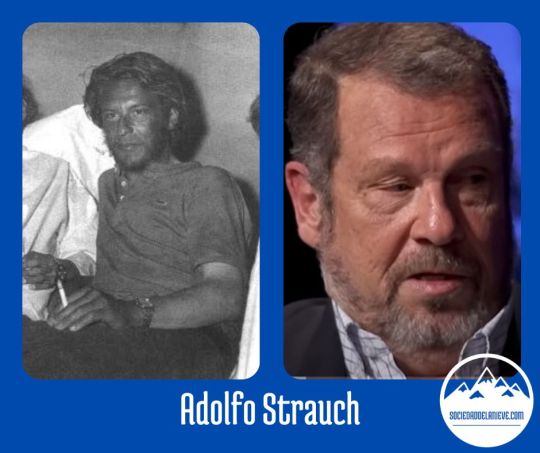
Born on April 19th 1948, “Fito” Strauch used to play for the Old Christians rugby team, but he didn’t at the time of the crash. He was invited on the trip by his cousin Eduardo Strauch.
He was part of the trio known as “the cousins” (Fito, Eduardo and Daniel Fernandez). Fito and Eduardo were double cousins, as their mothers were sisters and their fathers were brothers, whose sister was Daniel’s mother.
The cousins played an essential leadership role in the mountains, as they took the responsibility of cutting the meat off the dead bodies and rationing the portions.
Fito had many brilliant ideas. The boys had a hard time melting snow, as shaking handfuls in a bottle was far too arduous and tiring in the rarefied air of the mountains. Fito figured out that each plane seat had a piece of aluminum that could be folded into a device filled with snow, which was then left in the sun to melt. The resulting water would then be poured into a bottle.
He also came up with the idea of tying seat cushions to their feet so they could walk on snow without sinking to their waist. As if those were not enough, he manufactured sunglasses with pieces of nylon taken from the seats and glass cut from the front windows of the plane (the ones in the cockpit, which were a shade darker than the windows in the cabin)

Born on November 1st 1947, “Pancho” Delgado was a law student. He was invited on the trip by his friend Gaston Costemalle, who played for the Old Christians rugby team.
Due to his eloquence, the other survivors asked him to address the journalists in the press conference held upon their return to Uruguay and explain their decision to eat the bodies of their dead friends.
The book “Alive” by Piers Paul Read paints an unfavorable picture of Pancho, claiming he already had a “lawyer’s mind” and hoarded food behind everyone’s back. In his own book, however, fellow survivor Nando Parrado comes to his defense, saying that all survivors - due to the desperate circumstances they found themselves in - tried to take advantage of the others at some point, but Pancho was resented the most because he got away with it more often.
Pancho had a girlfriend at the time of the crash, Susana Sartori. The couple eventually got married and had four children (María Federica, Alfredo, Joaquín and Agustina).
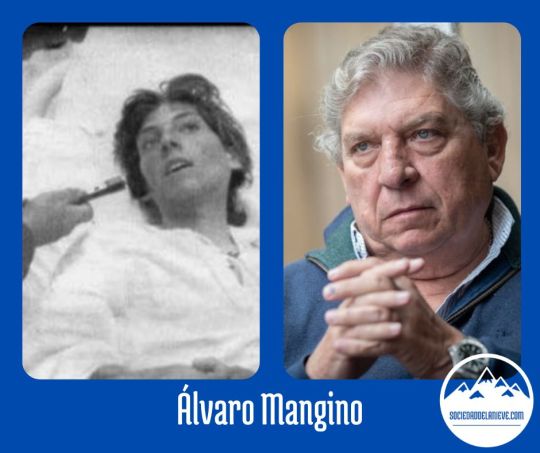
Born on March 31st 1953, Alvaro wasn’t part of the team nor did he attend the Stella Maris private school as most of the survivors. He knew some of the other passengers on a superficial level, as they lived in the same rich neighborhood in Montevideo. I have yet to find out why he was on the trip at all, but as soon as I do I’ll update you guys.
He broke his left leg when the plane crashed. Fellow survivor Roberto Canessa, a medical student, did his best to put the bones back into their places. Throughout the 72 days, Alvaro remained close to Canessa, who was very protective of him.
Alvaro had a girlfriend at the time of the crash, Margarite Arocena. The couple got married and had four children.

Born on July 24th 1953, “Tintín” played rugby for the Old Christians and stood out for his physical strength. His volatile personality caused some fights, but he never questioned the group’s decisions.
Because of his strength, Tintín was initially enrolled as one of the survivors who were to leave the fuselage in search of help. After three days, however, his fellow expeditionaries (Roberto Canessa and Nando Parrado) realized the trip was gonna be much longer than anticipated and sent Tintín back to the fuselage so they could keep his portions of meat.
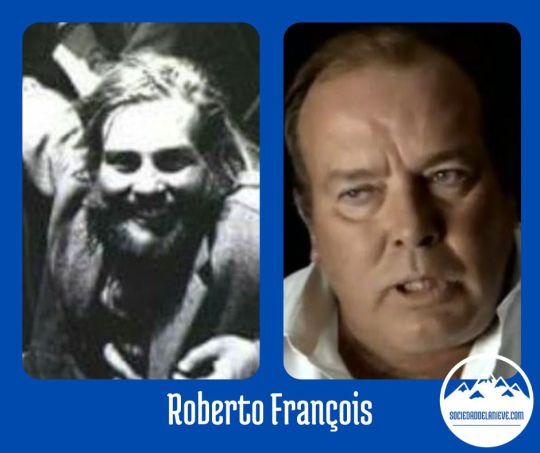
Born on November 23rd 1951, Bobby was a Stella Maris alumnus and played for Old Christians. He had a very passive attitude towards the whole ordeal, as if he didn’t care whether he lived or died. As soon as the fuselage stopped its descent down the mountainside, Bobby exited the wreckage, sat on the snow and lit a cigarette.
He melted snow when the others forced him to, but didn’t do much else. When the cousins threatened to cut off his supply of meat, Bobby shrugged and said “That seems fair”.
Bobby had six children (Roberto, Federico, Sofía, Josefina, Milagros and Diego) and now lives a quiet life as a farmer.
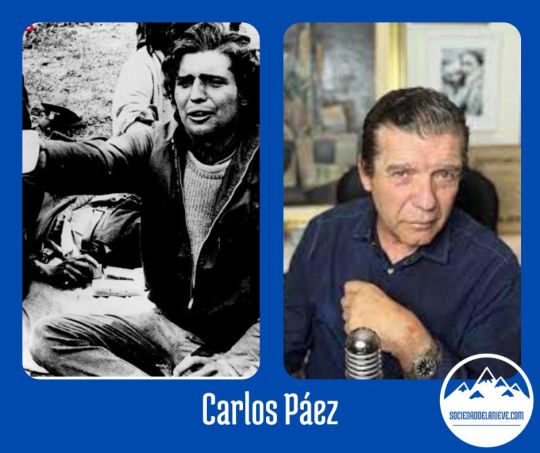
Born on October 31st 1953, Carlitos was the son of a famous Uruguayan painter, Carlos Páez Villaró, who searched non-stop for the wreckage of the plane and did not rest until his son was found.
Carlitos was a very spoiled boy (he had a nanny!), but the experience in the Andes built his character and soon enough he was in charge of important tasks such as building a wall made of chairs and suitcases to protect the severed fuselage from the cold and praying the rosary every night with his companions. He also knew how to sew, which came in handy when the survivors decided to make a sleeping bag for the expeditionaries.
Several years after the accident, Carlitos struggled with addiction, but he fortunately bounced back. He has two children, Maria Elena de los Andes and Carlos Diego (named after his deceased friends Gustavo Diego Nicholich and Diego Storm).

Born on February 12th 1946, Daniel is the second oldest survivor. He was unharmed in the crash.
As previously mentioned, Daniel and his cousins played a key leadership role after the death of team captain Marcelo Perez. Daniel’s serenity, in particular, calmed the others down when fights erupted.
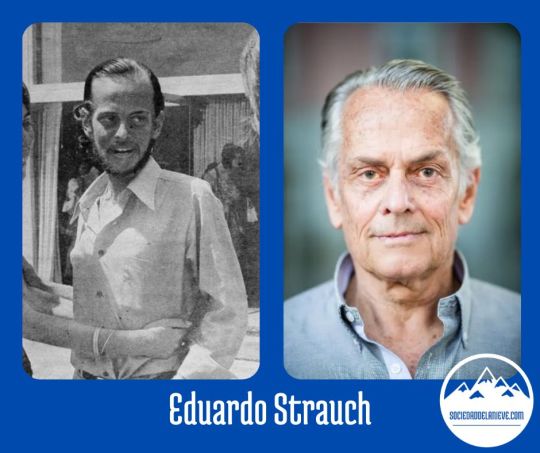
Born on August 13th 1947, Eduardo was a Stella Maris alumnus and confounder of the Old Christians, as well as a former player. Nicknamed “the German” due to his ancestry, he was an Architecture student and the most worldly of the group, as he had previously traveled to Europe.
Eduardo invited his cousins Adolfo Strauch and Daniel Fernandez on the trip.
Stay tuned for PART 2!
56 notes
·
View notes